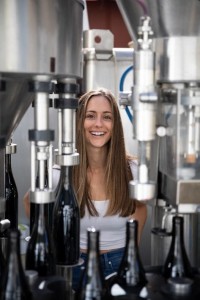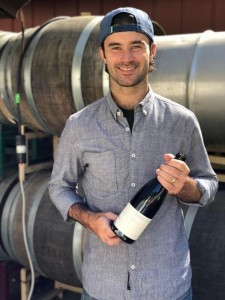The two of you met at college while you were students. When did you first start talking about making wine? Were you both “all in” or did one of you have to talk the other into it?
Tom: We didn’t really think about wine until a couple of years after graduating. In 2014 we were living in Washington, DC and visiting different wine bars in the city. After doing a Google search for “what is Beaujolais,” we started reading and learning more about the basics. Then in 2015 we traveled to Northern California and made our first visits to wineries. This experience solidified my passion for continuing to learn about the industry and ultimately led me to taking a part-time tasting room job in Middleburg, VA. Fast forward to June 2016; I decided to propose to Ashley and took her to Bordeaux to visit wineries and vineyards. Following that I signed on for a harvest internship to see if winemaking was a realistic option for the future. Later that Fall we moved to Napa and I worked my first harvest.
 Ashley: We had never been to a vineyard or winery while we were students. In fact, we hadn’t even visited Northern California until 2014 when we did a ten-day road trip from San Diego to San Francisco. We were dating at the time, craving adventure, exploration, and new experiences. I was “all in” on my yoga career; Tom was still searching for his passion. My colleague booked a tour for us at Tres Sabores Winery; looking back, the impact of that one experience created a new trajectory in our lives. We were enamored by the world of growing and making wine. We were inspired by the connection — with the Earth, with cultures around the world, with history dating back to pre-biblical times. A year later, Tom started working in a cellar in St. Helena and it became obvious that we were both “all in” on the idea of winemaking.
Ashley: We had never been to a vineyard or winery while we were students. In fact, we hadn’t even visited Northern California until 2014 when we did a ten-day road trip from San Diego to San Francisco. We were dating at the time, craving adventure, exploration, and new experiences. I was “all in” on my yoga career; Tom was still searching for his passion. My colleague booked a tour for us at Tres Sabores Winery; looking back, the impact of that one experience created a new trajectory in our lives. We were enamored by the world of growing and making wine. We were inspired by the connection — with the Earth, with cultures around the world, with history dating back to pre-biblical times. A year later, Tom started working in a cellar in St. Helena and it became obvious that we were both “all in” on the idea of winemaking.
You both were born on the East Coast and had great jobs there. Did anyone ever tell you how difficult it would be to make a living at winemaking?
Ashley: Absolutely. We’ve been told how difficult it will be to make a living by our families, mentors, and advisors. I think that’s part of what energizes us to pursue it.
It is widely reported that moderate wine consumption is good for your health. Ashley, as a registered and experienced Yoga teacher how does wine fit into your lifestyle?
Ashley: One of the key principles in Yoga is finding balance. For example, balancing “sthira” and “sukha”, or “effort” with “ease”. Working in the wine industry also requires balance and I believe this concept is especially important when working around alcohol.
Tom, you also have a day job as a sales rep for Springboard Wine Company, known for launching small, family-owned boutique brands. Are there things you’ve learned from this experience that help you build your own brand?
Tom: Absolutely. After working a couple harvests and learning the basics of winemaking, I kept hearing over and over again that the hardest part of making wine is selling it. Since cellar positions are scarce, this led me to search for a wine sales position. I already had experience in software and medical device sales; with my newly acquired knowledge of wine it was a natural fit. I have learned so much already — how to access the buyers/decision makers, presenting wines relative to the account, on premise vs. off-premise, pricing, etc. We are constantly learning. This experience has really helped us position ourselves (we think!) for future success and allows me the flexible schedule to handle all of our winemaking during harvest.
Tom, you’ve played team sports – including hockey – which is classified as a “collision sport” and one in which teammates look out for one another. How did that experience prepare you for the competitiveness in the wine industry?
Tom: I would actually shift this question from hockey to tennis. I did play hockey for a large part of my life, but as I was a bit “undersized,” I picked up tennis as well. I was years behind my peers when I started playing tournaments but the “underdog” status was incredibly motivating. At that point I decided to put all of my energy into tennis to catch up and by 18 I was ranked #3 in New England and in the top 200 in the United States. From there I was able to play NCAA Division 1 at Elon University. That journey is the source for my inspiration today. Ashley and I don’t come from a wine family, we are not from California, we have minimal formal training in winemaking–we are newcomers. These thoughts provide the same motivation as I had in tennis – to show up early, stay late, ask too many questions, and constantly read and learn as much as possible.
You launched Darling Wines in 2017 with just two barrels of Syrah. Why did you choose Syrah as the varietal for such an important step in your winemaking journey?
Ashley: We knew the first vintage would carry high risk. Syrah offered a friendlier barrier to entry so that we could take on that risk.
 Tom: More importantly, we love Syrah. It is one of the most fascinating grapes to work with; you can harvest at 12% or 15% potential alcohol, choose to destem or use whole clusters, and make a perfectly balanced wine. It is a chameleon in that way, which is not true with many other varietals, and this allowed us to explore which style and technique is most representative of our ethos.
Tom: More importantly, we love Syrah. It is one of the most fascinating grapes to work with; you can harvest at 12% or 15% potential alcohol, choose to destem or use whole clusters, and make a perfectly balanced wine. It is a chameleon in that way, which is not true with many other varietals, and this allowed us to explore which style and technique is most representative of our ethos.
After working with Napa wines, we really gravitated toward the coast. Once zeroing in on coastal vineyard sites, the most inspiring Syrah’s we tasted were the more savory, floral, and classic styles; we focused on finding a vineyard that was capable of this level of expression and was cool-climate, higher elevation and well drained. That led us to McEvoy Ranch.
What other varieties does Darling work with and why have you chosen them? How has the wind in the Petaluma Gap impacted the flavor profiles of your wines?
Tom: After our 2017 Syrah, we continued to explore the coastal vineyard sites and to taste as much as we could; we were inspired by Pinot Noir and Chardonnay, and more specifically, the more restrained styles of these varieties.
Pinot Noir gave us similar options as Syrah, flexibility with earlier harvesting and use of stems, so this was a natural choice. It has become an obsession and we are creating our own criteria for vineyards that fit that expression–high acid sites with earlier bud break and longer hang time i.e. utilizing Petaluma Gap’s wind, fog pressure, and moderate climate, courtesy of San Pablo Bay and the Pacific Ocean.
Chardonnay seemed to get a bad rap in our circle of family and friends. Oaky, buttery, sweet, are some of the reasons our customers steer clear, so we created a challenge for ourselves to make a more refreshing style that they can appreciate. Harvesting earlier, adding no new oak or batonnage, and keeping bright acidity are some of our criteria. We are excited for what is in barrel right now.
Ashley: Our favorite and most memorable wines are Pinot Noir and Chardonnay from France. These wines have stuck in our minds and touched our hearts with a certain wow-factor. We’ve chosen to work with them in an attempt to produce the style of wine we love to enjoy at home on our own dinner table.
You select fruit sources based on the vineyard size and the owners’ commitments to sustainability. Which vineyards have you chosen to work with?
Tom: Searching for sustainable, organic and biodynamically-farmed vineyards led us to smaller, family-owned sites. We are currently working with Azaya (Organic), McEvoy Ranch (Organic), Keller Estate (Organic and practicing Biodynamic), Grand Vent (practicing organic, no Glyphosate) and Flocchini (practicing organic, no Glyphosate). Finding vineyard partners who take a stand on stewardship and organics gives us confidence that the wines we put in our customers hands will not have any harmful chemical residuals in the finished product. Their investment in our wine also supports family-owned farms and vineyards.
Your wines are aged in neutral oak. Do you use neutral oak for all your wines, and if so, why?
Tom: Working with different vineyards, our goal has been to learn how each individual site expresses its terroir, whether that is in Western Marin or off Lakeville Highway on the way to Sonoma. By starting with as few variables as possible (i.e. all neutral oak, whole cluster, low SO2, native yeasts, etc.), we can create a transparent window into the characteristics of each vineyard and adjust our program as needed. With our 3rd vintage now in barrel, we still haven’t seen the need for new oak.
We’ve heard that you foot-stomp the grapes. Do you do this together? Is it hard work or fun? What does this old-world method do for the flavor profile of your wines?
Ashley: Yes, we do it together and it is pure fun!
Tom: We use this technique when fermenting whole cluster. At the beginning of fermentation, we gently tread to break up clusters and release juice and sugar to get the native yeast going. Then, we continue to foot tread throughout the ferment, a little each day as needed, to continue slowly feeding the yeast. We also use punch down tools by hand at the end of fermentation and are using our hands and feet as much as possible instead of pumps and machinery. As for flavor, we love the savory and floral character when fermenting whole cluster and we also gain texture on the palate from the stems.
What’s next for Darling Wines?
Ashley: We’re planning to launch the Darling Wine Club this spring! We’re also crafting in-depth monthly, educational newsletters to connect with our consumers. Tom and I daydream of brick and mortar–winery or vineyard property–some space to bring our real vision to life, and a couple little Darlings running around!
Tom: We want to expand our production. We currently produce 400-500 cases and have received some great, early support from restaurants like Zuzu, The French Laundry, Meadowood, Bouchon, and Redd Wood. The rest of our wine goes to our mailing list. As we continue to learn about new vineyard sites and possibilities we will expand, maybe adding a new varietal and some regional blends, to complement the wine club launch.
